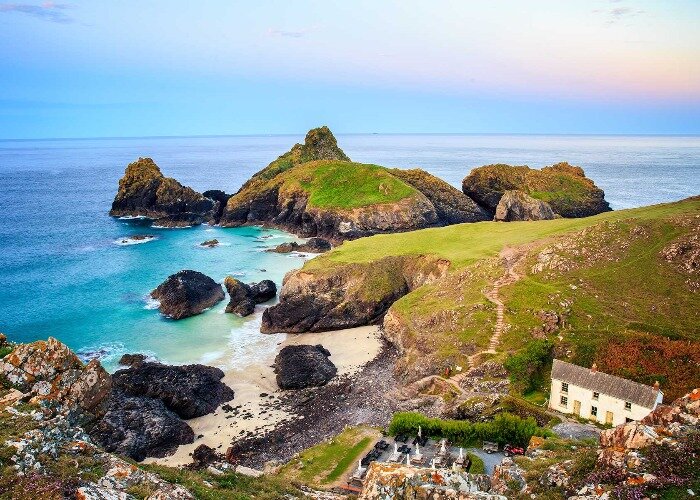
South Cornwall
A Short Guide to South Cornwall
Written By: Anika Akthar
Majestic. Yes, that’s the only way to describe South Cornwall. The southernmost part of the country has some impressive places to see that will leave you breathless. A merge of vibrant colours against the grand backdrop of South Cornwall will make you pinch yourself. Am I really in England?
Imagine walking with a warm pasty in hand, the cool breeze and salty sea air pinching your cheeks. That’s how you know you’re in the south of Cornwall. In our quick but definitely not exhaustive guide, we will take you on a journey through this part of Cornwall, exploring various places perfect for anyone, from families to the lone adventurer.
If you would like to continue this excursion with us, then read on and let us know if you have been to any of these hidden gems.
St. Michaels Mount
Fe Fi Fo Fum, St Michaels Mount is surrounded by lore’s and legends, one of the most notable being the giant who made the mountain his home. Cormoran the Giant could only be defeated by Jack the giant slayer. For the extra curious, see if you can spot the giants stone heart embedded onto the mounts’ wall.
This National Trust site is still lived in by the same St Aubyn’s family who acquired the estate in the mid-17th century, the castle and the adjoining gardens are steeped in history. As you walk through narrow corridors and bend to get past doorways, make sure to watch out for some of these interesting items:
A clock that tells you the time of the tide
The sofa where Queen Victoria sat sipping a cup of tea while she was entertained
A mummified cat
A piece of Napoleon’s coat worn in the Battle of Waterloo
Etches on a windowpane from a St Aubyn’s daughter, checking the authenticity of her engagement ring before accepting the proposal
These weird and wonderful items piece together to create a wonderful story embedded within castle turrets.
There is a world outside of the steep castle walls too. The adjoining garden is brought to life with bright flowers and subtropical fauna. The walled garden adds depth to the place, especially with the giant castle propped right at the top of the zig zag paths.
When tides are low, it’s a must to take the cobble-stoned walk across and into the Mount’s bay.
The Lizard
The dramatic cliffs edges of The Lizard won’t fail to amaze. Carved by the Atlantic Ocean, these looming cliffs guard the beaches below. The Lizard peninsula is the southernmost point on the British mainland. With maritime history running deep within the layers of the ocean, the Lizard holds many stories, some true and some verging on the side of folk tales. Chronicles of seafarers being lured into the cliff face by mermaids is what springs to mind when you see the crashing waves hit the jagged rocks.
There are many different walking paths around The Lizard Point, each displaying beautiful bright wildflowers and that picture-perfect view. Take in the striking landscape as you stand in front of the crashing wave. This is Cornwall.
Charlestown
The fishing village of Charlestown is located near St. Austell. With much of the village still retaining its old charms from the 1800s, a walk through Charlestown will captivate you as you take paths steeped in history. The tall ships that crowd the harbour brings a touch of the Cornish allure. As you sip a cup of coffee on the various seating across the deck, you can ponder along the bobbing boats and feel the charisma of this town come through. The raised pier is the perfect place to sit in as you look out into the bay with the calming waves gently colliding with the stone walls.
The port town has been used extensively in films and television. From Tim Burton’s Alice in Wonderland to the popular Poldark series. It’s no wonder tourists flock to Charlestown, the views are irresistible, and the culture is rich.
Falmouth
One of the larger towns in Cornwall is Falmouth. The port town is known for its crystal blue waterfront with the colourful bobbing fishing vessels often being the muse for many paintings and artistic creations. Falmouth has an artistic side that hails many artists to this vibrant town. From a renowned arts university and various art galleries, Falmouth has definitely made a name for itself in the arts scene.
The natural surroundings of Falmouth is also beautiful, with everything just walking distance. The beaches are perhaps Falmouth’s main attraction. Gyllyngvase Beach is popular with both locals and tourists. A wide expanse of soft white sand meets the bejewelled sea. This beach is a lot more family friendly with no cliffside and a lovely scenic walk which takes you towards Swanpool. Now, Gyllyngvase can get rather busy during the peak times throughout the year. If a calming walk on the beach is what you need then just a few steps away is Swanpool beach. Equally as beautiful as its sister beach, Swanpool is a lot less crowded with the added benefit of a lake with swans close by.
Along with the beautiful beaches, Falmouth offers many excursions. Take a boat trip to see the stunning coastline of Falmouth as you head around Roseland and St Mawes. Falmouth also has many beautiful gardens, Glendurgan Garden being iconic for its famous maze. Check out the wildlife that these subtropical habitats hold. Don’t forget the castles either! Pendennis Castle was built by Henry VIII to defend the area from France invading. Inside the fortified walls, you can find re-enactments of what would have gone on behind the high turrets. Falmouth is definitely a culture hub of Cornwall.
Land’s End
It’s in the name. Land’s End is really that, the land’s end. This westernmost point of mainland England is a popular tourist point. Land’s End is exactly what you think when you think of Cornwall. The overhanging cliffs with a concealed beach, the crashing waves against the side and the beautiful greenery that compliments the bright blue sea and sky.
However, it’s not just the postcard-worthy scenery that draws people to this place. The iconic signpost with directions to John O’Groats in Scotland and New York all the way across the Atlantic is another reason that gravitates people towards the edge of Cornwall. This, paired with the romantic backdrop of the cliff face and the rare flora spread across the fields of green is what make Land’s End a quintessential part of Cornwall.
